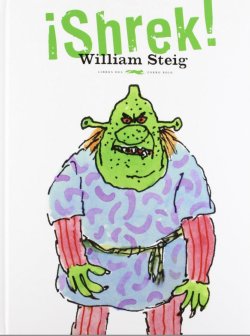Gareth B. Matthews

Review of Shrek! by William Steig (New York: Farrar, Straus & Giroux, 1990). Originally published in Thinking: The Journal of Philosophy for Children 15(1): 1.
Shrek is ugly, revoltingly ugly. Although his mother and his father are also very ugly, Shrek is even uglier than the two of them put together. In addition to being quintessentially ugly, Shrek is repulsive in other ways. For example, he can spit a flame a full ninety-nine yards in front of him; he can also vent smoke from each of his two ears.
“Hissing things over” one day, Shrek’s parents decide that Shrek should be kicked out of his home and sent out into the world to fend for himself. So, they do just that. As Shrek goes out into the world it delights him to see the flowers bend aside, the trees lean away to let him go by.
In the woods Shrek encounters a very ugly witch who is busy boiling bats in turpentine and turtle juice. She sings as she stirs her big pot of smelly stew. “What a lovely stench!” remarks Shrek gleefully. The very sight of Shrek in all his ugliness makes the witch woozy. When she recovers from her wooziness, she agrees to tell Shrek’s fortune in exchange for a few of his “rare lice.” In dog-gerel verse the witch tells Shrek that a donkey will take him to a knight whom he will subdue; then he will meet and marry a princess even uglier than he is.
Fired up with the thought of meeting his “fairy princess,” Shrek happily sets out on a mission to find her. Along the way he encounters a poor peasant, whose lunch he takes; he warms the lunch in the laser-like glare of his eyes and then eats it for his dinner. Sometime later Lightning and Thunder catch sight of Shrek and try to frighten him. But he just gobbles up Lightning’s fiercest bolt and belches out smoke in the way other people might burp after a heavy meal. On the edge of the next woods Shrek comes upon a warning sign, which threatens harm to anyone who ventures into the woods. Shrek swaggers right past the sign. A little way into the woods he does, in fact, encounter a dragon, which he promptly subdues.
Next, Shrek encounters the promised donkey, to whom he recites the magic words the witch had told him to use. The donkey carries him to the castle, where he encounters the promised knight and subdues him. In triumph he crosses the drawbridge and enters the castle.
Once inside the castle Shrek finds himself in a hall of mirrors. His frightful face is multiplied so many times that even he is frightened. But when he starts to run, so do all his reflections. On recognizing that it is just himself he sees in the many mirrors, Shrek goes on into the throne room, where he meets the most stunningly ugly princess on the surface of the planet. Shrek and the ugly princess fall completely in love with each other and decide to get married as soon as possible.
Here the story ends. Shrek and his unbelievably ugly princess get married and live horribly ever after, “scaring the socks off all who fall afoul of them.”
We can hardly expect that Shrek will be every child’s favorite story. Some children, we can be sure, will be “grossed out” by Shrek’s revolting face, head, and claw like hands. But some children will delight in Shrek’s incredible ugliness and will applaud his vulgar behavior. Why?
No doubt Shrek offers at least a temporary respite from the oppressive demands adults in our society lay upon children, demands to look clean and beautiful and to act in ways that adults find attractive. In laughing at what makes their parents and teachers squeamish and uncomfortable, children can strike a blow for their own liberation.
Yet there seems to be more to this story than child liberation. Shrek (Schreck means ‘fright’ in German and Yiddish) raises an important question about whether there can be anything genuinely attractive, even beautiful, that is also extremely ugly.
In a way the answer to that question seems obviously to be ‘No’. The beautiful and the ugly are opposites. Nothing, it seems, could be both beautiful and ugly, or even ugly and attractive-at least not in the same respect.
Yet consider the Flemish painter, Hieronymous Bosch. His painting, The Temptation of St. Anthony, is full of loath some creatures. But the painting is an artistic masterpiece. It is nightmarishly beautiful and repulsively attractive.
The idea that art aims simply at the beautiful is, in fact, false. I once saw an art show in Vienna called “The Magic of Medusa” made up entirely of grotesquerie. It included Western art of all periods-from ancient depictions of the writhing snakes of Medusa through revolting Renaissance drawings of human anatomy in gruesome detail, to modern “masterpieces” of surrealism. It was a show devoted to the beauty of ugliness.
At Halloween many children are allowed to indulge their own fascination with the grotesque and the ugly. Their revolting masks and disgusting costumes are indulged, no doubt, partly because their parents realize that Halloween comes but once a year. But why not actually discuss with children the way some of them (and some of us!) become fascinated with ugliness? One can hardly imagine a better vehicle for that discussion than William Steig’s Shrek, which, incidentally, is attractively illustrated in revolting detail by the artist/author.
